Q: “What are you dressing up as?”
A: “My next door neighbor; some creepy guy.”
Q: “What are you dressing up as?”
A: “My next door neighbor; some creepy guy.”
 My good friends at Literary Safari are producing an ongoing Instagram graphic narrative that you need to check out. It’s at instagram.com/williambutlerms and it’s a serial work of dystopian fiction about… school shootings.
My good friends at Literary Safari are producing an ongoing Instagram graphic narrative that you need to check out. It’s at instagram.com/williambutlerms and it’s a serial work of dystopian fiction about… school shootings.
The premise of the narrative is that williambutlerms is the official Instagram of the the fictional William H.G. Butler Middle School, a school that has suffered a horrible shooting that left some students and teachers dead. The serialized story reveals an Orwellian world where school shootings are the norm. (Actually, tragically, that’s not that Orwellian…)
The format of the williambutlerms narrative is very clever, both in terms of subject matter and the Instagram “delivery system.” It’s rife with hashtags and feels very connected to our techno-cultural moment. What I think works so well is the presentation, with the narrative building one disconnected image at a time. It’s like a jigsaw puzzle that slowly comes into focus one piece at a time. The artwork has a primitivist quality which fits the middle school theme. (I wouldn’t call williambutlerms a comic per se, but it definitely falls under the rubric of a “graphic narrative.”)
And what makes the whole thing work is the deadpan satire of the piece, which is so cutting! The narrative starts with a bang (apologies for the inappropriate metaphor) with an opening shot of the school yearbook, featuring some murdered students (and some clever “gun”-related yearbook quotes). Other highlights are a “Targeted School Supplies” series of products, and some clever parodies of famous middle-school/high school texts — The Things They Buried, The School of Mango Street, etc. Good stuff. This tone works incredibly well, as it highlights the very real struggles that schools and educators are currently facing (with no help from the federal government).
williambutlerms debuted in June and a new post appears every Tuesday, Wednesday, and Thursday through the end of the summer. Check it out.
 Writer Gavin Edwards has produced a cool new book called The Beautiful Book of Exquisite Corpses: A Creative Game of Limitless Possibilities (due out August 28), and I’m one of the contributors.
Writer Gavin Edwards has produced a cool new book called The Beautiful Book of Exquisite Corpses: A Creative Game of Limitless Possibilities (due out August 28), and I’m one of the contributors.
You can be a contributor too, because the premise of the book is based on the old surrealist game cadavre exquis, in which a collection of words or images is collectively assembled. Much of the book works like the “parlor game” Picture Consequences, where a piece of paper is folded into three sections. The first player draws the head—leaving only small connective lines for clues—and passes it unseen (by means of folding) to the second player who draws the body, then on to the third player who draws the legs. The composite person or creature is then revealed to all by unfolding the paper.
Each page of the book has one of the three section already drawn in, leaving two other sections for you and your friends/family to fill in. Other parts of the book take the same premise, but with words, using a single sentence to launch a story.
Sparking off the various images and stories are 90 visual contributors and 20 verbal contributors, such as tons of cool cartoonists (the likes of Dean Haspiel, Jessica Abel, Leela Corman, Jim Woodring, Dustin Harbin, etc.) and an eclectic group of others like authors Aimee Bender, Chuck Klosterman, and Susan Orlean, actor Griffin Dunne, former baseball player Lenny Dykstra, musicians Chris Frantz and Robyn Hitchcock, comedian Stephen Fry, journalist Emily Nussbaum, DJ Moby, and former VJ Martha Quinn. Take a good look at this gift for a journalist I got on this website, check out more here.
As a cartoonist I’ve always been fascinated by “collectively assembled” projects, going back to collaborations with writers like Harvey Pekar, Brooke Gladstone, and Nick Flynn; the exquisite corpse comic I did with Dean Haspiel, Because of You; and of course Flashed: Sudden Stories in Comics and Prose, which I co-edited with my brilliant wife Sari Wilson.
In honor of the project, this past weekend Sari, Phoebe and I did a couple of “Picture Consequences” drawings on napkins at the local diner. This one has been dubbed the Chicken Seawitch. Can you figure out which of us drew which section?

And here is a Nosehair Ketchup Hero. Again, can you figure out who did what?
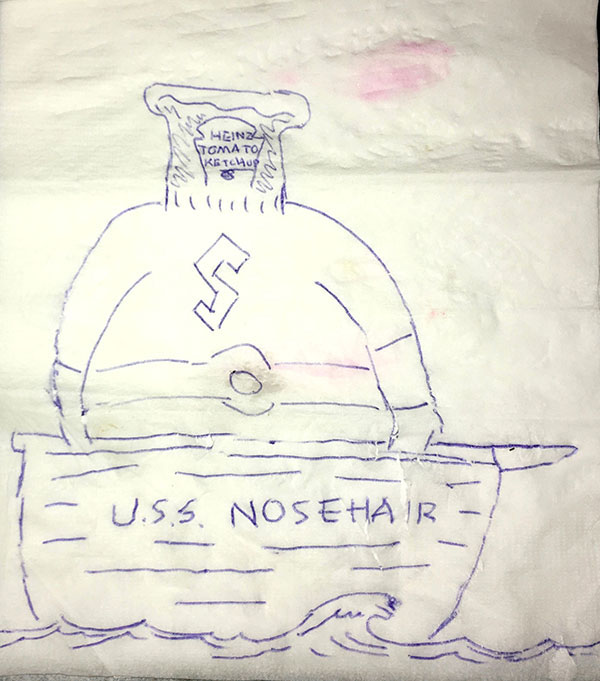
The Beautiful Book of Exquisite Corpses is due out August 28. Here’s a link to pre-order…
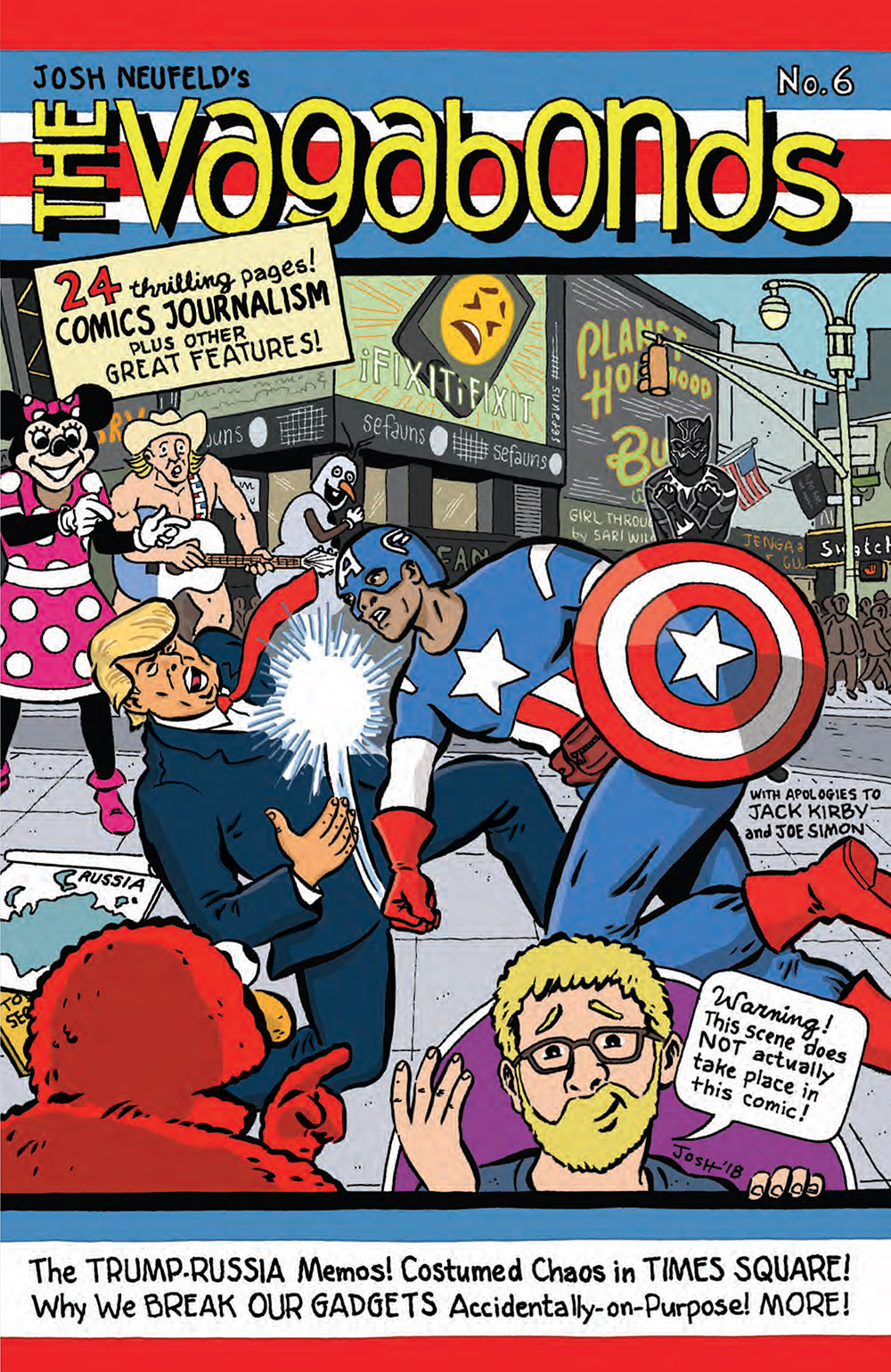
My homage to Captain America Comics #1 (with apologies to Jack Kirby and Joe Simon)
I’ll be tabling at MoCCAFest this weekend (table I 270 A) with the latest issue of THE VAGABONDS. 24 thrilling pages of COMICS JOURNALISM and other great features!
A lot has changed in this country—and the world—since the last issue of The Vagabonds, so it’s only fitting that this issue features a Donald Trump story. My explainer on the former British spy Christopher Steel’s “dossier,” originally published by Columbia Journalism Review in the fall of 2017, remains surprisingly relevant, as the special counsel seems to be using the memos as a “road map” for his investigation into collusion between the Trump campaign and Russia. This issue’s longest story—originally published by The Nib in the fall of 2016—looks into the influx of costumed characters into New York’s Times Square. In the piece I explore the phenomenon — who are these unlicensed Elmos, Spider-Men, and Minnie Mice, and why are they there? This issue also features a fun story I did for Harvard Business School’s Working Knowledge. Do you often find yourself losing or breaking your old phone just when a new model reaches stores? Well, you’re not alone… The story shows how researchers — using the game of Jenga and a precious coffee mug—were able to get test subjects to replicate this risky, self-destructive behavior. THE VAGABONDS #6 closes out with a couple of shorter pieces, including a collaboration with my mother, the artist Martha Rosler.
I look forward to seeing you at MoCCA Fest this weekend and handing you an autographed copy of THE VAGABONDS #6. (And of course I’ll have copies of previous issues of The Vagabonds, as well as A.D., The Influencing Machine, Terms of Service, Flashed, and much more!)
MoCCA Fest 2018—April 7-8, 2018
11:00AM – 7:00PM on Saturday; 11:00AM – 6:00PM on Sunday
Metropolitan West
West 46th Street between 11th and 12th Avenues, NYC
Last year Anthony Lacey of the fabulous blog Dining with Strangers approached me for an original illustration of himself and Brobson Lutz, the esteemed “Doctor” character from A.D.: New Orleans After the Deluge. (Anthony had met the Doctor in New Orleans—sharing a meal with him at Dr. Lutz’s favorite restaurant, Galatoire’s—and profiled him for his blog; and they have stayed friends every since.) Anthony’s plan was to present the finished illo to Dr. Lutz as a gift when Anthony was down in NOLA for this year’s Mardi Gras. Always happy to do commissions—and revisit one of my favorite A.D. characters—I of course said “yes.”
To get started, we agreed on a size and format, and Anthony sent me a couple of photos from their meal, as well some recent interior shots of Galatoire’s—which of course hasn’t changed at all in recent memory. Taking those reference photos as a basis, I first worked up a sketch for Anthony’s approval, which I executed on my Cintiq tablet:
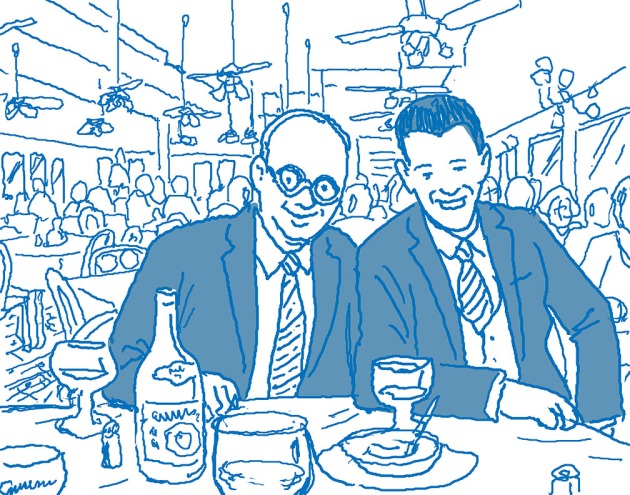
Anthony having approved the sketch, I moved on to full pencils—which zoomed in on my two subjects a bit more (and moved the Doctor’s left arm up on to the table)…
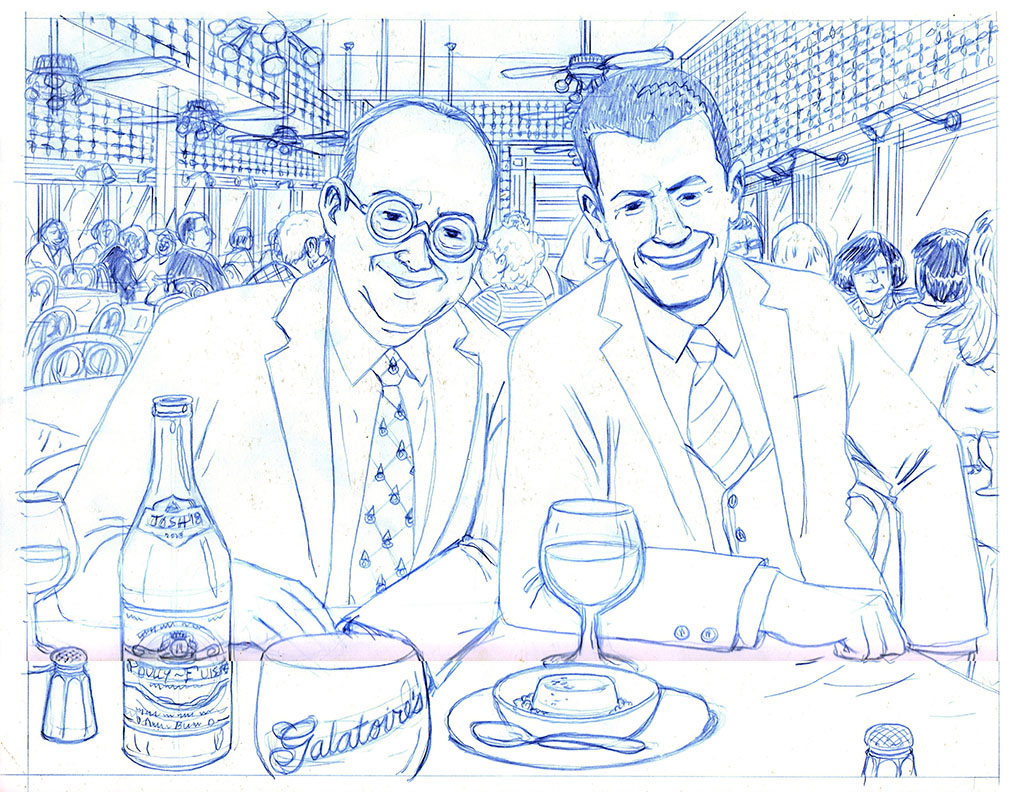
For the inking stage, I realized I wasn’t happy with the placement of the Doctor’s hands, which were being blocked by the Galatoire’s serving dish in the foreground. So I “moved” the dish a bit to the right. In addition, because the background of the picture is so busy, I made sure to ink Anthony and the Doctor with thick brushstrokes, while inking the background in much thinner lines. This helped “pop” the main subjects. I also fine-tuned details throughout the drawing…
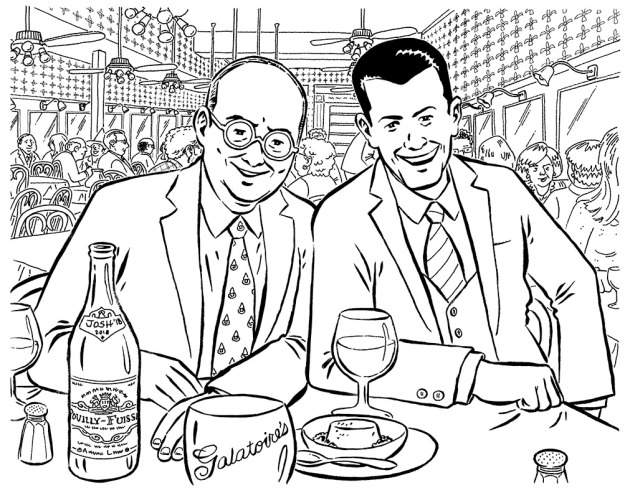
Finally, for the color stage, I wanted to be a little more “adventurous” than the limited palette which defines A.D. But again wishing to bring forward the Doctor and Anthony, I colored them with “hotter” and more saturated tones, while keeping the background elements more limited in palette. I then applied my “patented” texture pattern on top, and… voila! 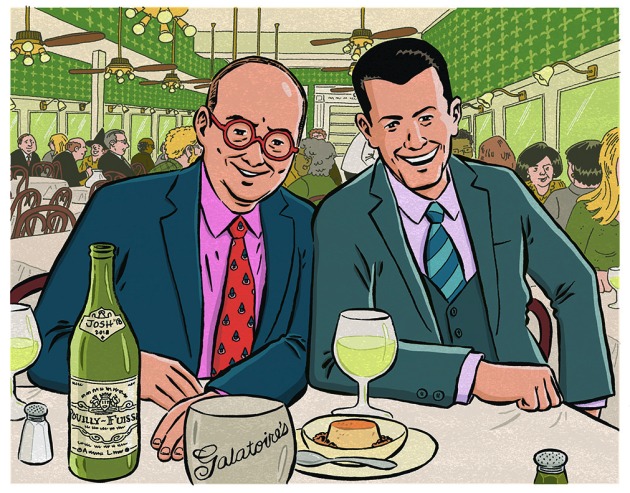
I printed the final illo on a nice ragstock paper at 11″ x 14″, and sent it off to Anthony, who had it professionally framed. From what I heard, the unveiling was a big success, and the print is now hanging in the Doctor’s house amidst his eclectic art collection.
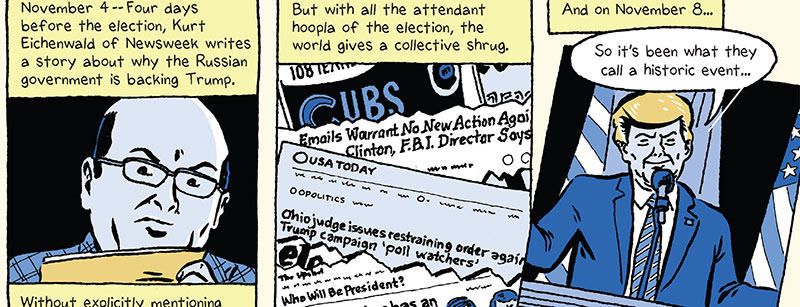 Remember the Donald Trump-Russia “dossier”? Released by BuzzFeed in January (shortly before Trump was sworn in as U.S. President), the 17 short memos (compiled over seven months) featured some pretty wild claims—sex parties, etc. But the main takeaway was that Trump and his cronies were in the pockets of the Russians.
Remember the Donald Trump-Russia “dossier”? Released by BuzzFeed in January (shortly before Trump was sworn in as U.S. President), the 17 short memos (compiled over seven months) featured some pretty wild claims—sex parties, etc. But the main takeaway was that Trump and his cronies were in the pockets of the Russians.
Amidst the furor over the memos’ contents was an equally strong uproar in the journalistic community. Was it ethical of BuzzFeed to publish the so-called dossier, which was unverified and contained some specific errors? The backstory, of course, is that during the previous months, the memos—and their author, former British spy Christopher Steele—had passed like a hot potato through every major news organization before BuzzFeed finally pulled the trigger. So was the outrage honest, or really just a case of sour grapes at being scooped? A new piece I just did for Columbia Journalism Review—“The Trump-Russia memos”—tracks that long strange journey.
The events described in the five-page comics story are based on reporting and research, including interviews I did with journalists who sought to verify the memos and wrote about them—or chose not to…
As far as the actual contents of the memos, none of the more outlandish claims have been verified—although the FBI and Special Prosecutor Robert Mueller apparently are using the memos as a “road map” for their ongoing investigation into the Trump campaign and Russia…
So check out the piece and see what you think. (Thanks to Vanessa Gezari for commissioning the piece and shepherding me through the whole process.)
 The brilliant creative souls Rob Walker and Josh Glenn have a new ongoing PROJECT:OBJECT. Lost Objects is a 25-part series of nonfiction stories about… lost objects. It’s the fifth P:O series, which started with Significant Objects (featuring, among others, a great piece by our very own Sari Wilson), then Political Objects, followed by Talismanic Objects, and then Illicit Objects. (That last one also features a piece by Sari.) Other contributors include Paul Lukas, Jessamyn West, Douglas Rushkoff, William Gibson, Doug Dorst, Kate Bernheimer, Michael Tisserand, Randy Kennedy, Seth Mnookin, Luc Sante, and many, many more.
The brilliant creative souls Rob Walker and Josh Glenn have a new ongoing PROJECT:OBJECT. Lost Objects is a 25-part series of nonfiction stories about… lost objects. It’s the fifth P:O series, which started with Significant Objects (featuring, among others, a great piece by our very own Sari Wilson), then Political Objects, followed by Talismanic Objects, and then Illicit Objects. (That last one also features a piece by Sari.) Other contributors include Paul Lukas, Jessamyn West, Douglas Rushkoff, William Gibson, Doug Dorst, Kate Bernheimer, Michael Tisserand, Randy Kennedy, Seth Mnookin, Luc Sante, and many, many more.
For Lost Objects, Josh G. & Rob W. asked 25 writers to tell them about a significant object they’d lost (or thrown away, or destroyed), then assigned these stories to 25 illustrators. Thusly, Dan Piepenbring of the Paris Review wrote a piece, about a bottle of cologne, and yours truly illustrated it. And here it is—as you read, you’ll should soon see why I was compelled to do it.
Enjoy—and then make sure to check out all the other great contributions to the PROJECT:OBJECT series.
The A.D.: New Orleans After the Deluge website on SMITH was down for a while, but recent events with hurricanes Harvey & Irma made it imperative to get it working again—and so it is: smithmag.net/afterthedeluge. This terrible 2017 hurricane season obviously brings back memories of 2005 (and for older folks, previous big hurricanes that hit big cities). As I wrote in the book’s afterword, the stories in A.D. are highly specific yet somehow universal, and over the years I have found in my discussions about A.D. that the experiences of the real-life characters therein resonated strongly with other hurricane survivors in so many ways. People told me this over and over as I traveled around promoting the A.D. book—in New Orleans (of course), in Houston, in Miami, and even in New York City. By connecting to the stories of Denise, Leo, Michelle, Hamid, Mansell, Kwame, and the Doctor, people gained comfort—and context—for their own experiences.
Watching Harvey and Irma, the cycle feels so similar: tracking the storm, deciding whether or not to evacuate, dealing with the wind damage and flooding, confronting loss—of people, possessions, community—and the long rebuilding process. These are the perennial issues brought on by these epic man-vs.-nature events…
The New York Times‘ coverage of the storms has been particularly good, and these stories reminded me so strongly of specific moments from A.D.:
“Irma Shifting Forecasts: It’s All a Matter of Probability” evokes “Should I Stay…”

The Daily story, “How Houston Was Built to Flood” evokes the Prologue, Part II—“The Storm”

“Thousands Cried for Help as Houston Flooded” evokes Chapter 6—“Flotsam & Jetsam”

“After Harvey, a Return Home in High Water” evokes Chapter 8—“The Bowl Effect, Part II”

The Daily 360 piece “On Submerged Streets: ‘Houston Has Come Together'” evokes Chapter 10—“Something in the Water”

The photo essay “What They Saved: Texans Reflect on Treasures Plucked From Harvey” evokes the epilogue, “Picking Up the Pieces”

… as does “We Lived Through a Flood. Now We Have a Very Long To-Do List.”

Part of the A.D. experience on SMITH was the links embedded within certain panels that extended the story in various ways: to hurricane resources, YouTube videos, audio clips of the various characters. As part of resurrecting the A.D. site, I also updated all those links, which to my mind all remain relevant for these storms 12 years later. My hope—as it always was—is that the stories of the various real-life people from A.D. continue to give solace and understanding to this new generation of hurricane watchers and survivors.
Stay strong, Texas. Stay strong, Florida.
Scene: Interior Washington Gourmet Deli bodega.
Customer: Yo, lemme get a stamp!
Bodega guy: No stamp, no stamp.
Customer: No stamp?! … Okay, lemme get a Tylenol.
I’m proud to announce that this June 15-18 I’ll be teaching an intensive, immersive comics-making workshop at the Yale Writers Conference (part of the Yale Summer Session), held in New Haven, Connecticut.
This marks the first time I’ll be doing a comics workshop with YWC—it’s the first time they’ve done one—but it’ll be closely modeled on programs I’ve run a number of previous summers with the Fine Arts Work Center. Those workshops have always been a rewarding experience, both for me and my students.
Here’s the course description for my workshop Comics: Stories in Graphic Form:
Comics use words and pictures together to form powerful narratives. In this workshop, you will use fictional material, or material from your own life to create original comics. We’ll examine the basic principles of visual storytelling, and complete writing, brainstorming, and collaborative exercises that are useful in producing strong comics. We’ll generate ideas for solving storytelling problems—and look at how other cartoonists have grappled with them. We’ll use group feedback to hone our stories and find the narrative beats. You’ll emerge from this workshop with a toolset for taking your work to another level. In lieu of a writing sample, submit a 250-word description of your comics project and two character drawings with your application.
So, whether you’re interested in fiction, memoir, journalism, informed essay, or anything in between, this comics workshop is for you! The workshop is part of Session II of the YWC. Over four days, participants will meet in a seminar with eleven fellow cartoonists, led by yours truly. We’ll learn constructive criticism techniques that support productive feedback, followed by intensive group writing workshops, with the chance for each participant to showcase his or her writing and receive feedback/critique. (Participants will receive copies of their peers’ work in advance.) I will provide instruction on writing and drawing techniques, revision, and other “tricks of the trade.” And, during the conference I will hold half-hour, one-to-one meetings with each participant. Sounds great, right?
Click this link to find out more about the program and how to register. Please spread the word about the workshop, and encourage people to sign up soon. The deadline is April 30. Classes fill up quickly…